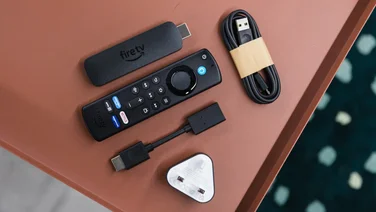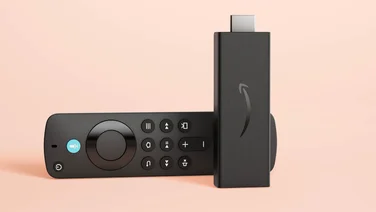To help us provide you with free impartial advice, we may earn a commission if you buy through links on our site. Learn more
- Amazon Fire TV Stick 4K Max (2nd gen) review: What you need to know
- Amazon Fire TV Stick 4K Max (2nd gen) review: Price and competition
- Amazon Fire TV Stick 4K Max (2nd gen) review: Design
- Amazon Fire TV Stick 4K Max (2nd gen) review: Performance
- Amazon Fire TV Stick 4K Max (2nd gen) review: Verdict




- Snappy performance
- Excellent image and audio quality
- Dolby Vision, HLG and Dolby Atmos support
- Still very Amazon-centric
- Limited app store
- Conversational search is a work in progress
The Amazon Fire TV Stick 4K Max (2nd gen) is one of the fastest and most powerful streaming sticks around and perfectly equipped to navigate the ever-changing landscape of 4K streaming.
Things move fast in the world of 4K streaming and even modern smart TVs and streaming sticks sometimes struggle to keep up. Apps get updated, new wireless standards come in to improve connection speeds, and processors that once handled streaming duties with ease make loading programmes or switching apps look like hard work.
But the Fire TV Stick 4K Max (2nd Gen) has no such troubles. It not only delivers a speed boost over the 2021 model but also Wi-Fi 6E support and a handful of new features that improve the whole experience. In minutes, it can drag your smart TV out of the slow and laggy doldrums, straight into the present day.
Amazon Fire TV Stick 4K Max (2nd gen) review: What you need to know
This is the second generation of the Fire TV Stick 4K Max, itself a supercharged version of the earlier Fire TV Stick 4K. The new incarnation has a faster MediaTek MT8696T CPU, with its four cores boosted from 1.8GHz to 2GHz, along with an Imagination Tech GE9215 GPU running at 850Hz rather than the old 750Hz. It’s also the first Fire TV device to support Wi-Fi 6E. Even the mighty Fire TV Cube (3rd generation) is stuck with plain old Wi-Fi 6.
Beyond this, the biggest changes are to the software. The old 4K Max already supported Dolby Vision, Dolby Atmos, HDR10+ and HLG, but the new version is the first Fire TV Stick to include the Ambient Experience from Amazon’s Fire TV Omni QLED television, with background music, customisable widgets and an ongoing slideshow of curated photography or art. It also supports some new Alexa-powered AI features, designed to give you a more conversational approach to finding content.
READ NEXT: Best Android TV box
Amazon Fire TV Stick 4K Max (2nd gen) review: Price and competition
Amazon’s biggest competitor is arguably itself, with two other 4K streaming devices beyond the Fire TV Stick 4K Max. It’s just released a new version of the standard Fire TV Stick 4K, which does without the Ambient Experience and AI-enhanced search. It’s £10 cheaper but uses a less powerful MT8696D CPU running at 1.7GHz, with the same GPU clocked down to 650MHz. Wireless connectivity also stops at Wi-Fi 6.
The Fire TV Cube (2nd generation) is still faster than the Fire TV Stick 4K Max, with an 8-core CPU with four cores running at up to 2.2GHz and four cores at 2GHz. However, it has the same 2GB of LPDDR4 RAM and 16GB of storage, and it only supports Wi-Fi 6. Given that it’s twice the cost of the Fire TV Stick 4K Max, it only makes sense if you need its additional features, including the built-in Alexa speaker and HDMI 2.1 passthrough.
Outside Amazon’s ecosystem, you’re looking at the Roku Streaming Stick 4K (£50), Google’s Chromecast with Google TV (£60) and the 2022 Apple TV (£169). Roku’s stick is an excellent alternative, benefitting from a simple interface and excellent app support, but it can’t match the Fire TV Stick 4K Max on features. The Chromecast has a fantastic interface but some irritating foibles, while the Apple TV is so expensive that it only really works if you’ve bought into Apple’s ecosystem and want to use iOS apps and games on your TV. It’s more of a competitor to the Fire TV Cube than the Fire TV Stick 4K Max.
Amazon Fire TV Stick 4K Max (2nd gen) review: Design
Design-wise, the new Fire TV Stick 4K Max looks exactly like you’d expect: a slimline stick with an HDMI connector at one end and a micro-USB port for the bundled power supply on one edge. At 99 x 30 x 14mm, minus the HDMI connector, it’s identical in size to the regular Fire TV Stick 4K, not to mention the last-gen version of both.
Amazon includes a short extender cable to give you some flexibility and cover TVs where the HDMI ports are crammed in close together, and while you can theoretically power it from a USB port on your TV, you’re advised not to in order to maintain a consistent power level, and also ensure that the device is awake to turn your TV on and off.




Amazon supplies the Fire TV Stick 4K Max with its latest-generation Alexa Voice Remote Enhanced, which can control your TV’s power and volume as well as the streaming stick. Setting everything up is a remarkably easy process that you can run through manually using the remote or semi-automatically by installing Amazon’s Fire TV app on your smartphone.
Using the app, I had the Fire TV Stick 4K Max up and running in under 20 minutes with most of my streaming apps installed – and that included a firmware upgrade. You’ll need to spend a little more time entering your credentials on each app, but if you have your favourite streaming apps already installed on your phone, you’ll find that this is pretty easy too. On Disney Plus, for example, all you need to do is run the app on both units and allow the streaming stick to use your credentials via your phone.Amazon has pretty much mastered its TV UI these days, and it’s one of the slickest and most accessible smart TV interfaces around. It puts content front and centre, while making it relatively easy to find and use any installed apps, and the Alexa voice control works extremely well, with a handful of caveats.
On the one hand, it’s great at handling profiles on Amazon Prime Video and taking you to your current point in your current episode when you ask to watch, say, The Continental, The Marvellous Mrs Maisel or Gen V. And while it’s still very Amazon-centric, it’s getting better at pushing shows from a wider range of streaming services into your Next Up, Recently Watched and Recommended lists.
It’s not so good, however, at tracking Netflix or Disney Plus profiles, meaning that if you flick between different profiles, you can easily end up with your progress on a series or the titles in your watch list getting confused. This isn’t really Amazon’s fault as such, but it’s something to be aware of.




As for the new Fire TV 4K Max-exclusive features, Ambient Experience is actually pretty cool, with a choice of background images, widgets for weather, your calendar and creating on-screen post-it notes, plus the option to have Amazon Music, Spotify or Audible playing in the background.
When it comes to the AI-enhanced Search features, I can only assume these are a work in progress. Asking to find more films by the director of Guardians of the Galaxy, for example, didn’t find more films by James Gunn, but just more films featuring the titular super-team. Ditto a request for films featuring the actor who plays Winston in John Wick or the actress who plays Jo in Little Women. You’re still fine with simple searches by star, director, title or whatever, but these more complex conversational searches don’t seem to be online yet.
READ NEXT: The best cheap TVs to buy
Amazon Fire TV Stick 4K Max (2nd gen) review: Performance
To my mind, the best reason to get the Fire TV Stick 4K Max over the regular Fire TV Stick 4K or the Roku Streaming Stick 4K is its performance. It’s incredibly snappy, quick to load content and switch between apps. In my tests, there’s no noticeable speed difference between Amazon’s fastest streaming stick and the Fire TV Cube until you get to apps and games; even where the Fire TV Cube loaded an app or programme faster, we’re talking tenths of a second. And given that there are so few games worth playing on either device, I wouldn’t make a choice based on that. Hate tiny pauses for loading or buffering? Feel every fraction of a second counts? The Fire TV Stick 4K Max is the best streaming device you can buy without spending north of £100.
It’s also worth mentioning that, on the gaming front, the Fire TV Stick 4K Max is perfectly capable of handling Amazon’s Luna game streaming service. It’s a service hamstrung by its lack of content, and not currently worth paying extra for. However, if you’re an Amazon Prime subscriber with a Ubisoft Connect account and some Ubisoft PC games, you’ll find that you can stream those games for free through Luna without coughing up for a Ubisoft+ subscription. I spent an hour or so playing Far Cry 6, and it looked good and played pretty smoothly at 1080p.




Crucially, audio-visual performance is just as good as it is on the Fire TV Cube. There’s still an annoying wait on Amazon Prime Video while it switches stream from 1080p to UHD, but once it happens, picture quality is exemplary. Meanwhile, the audio through my Denon soundbar was actually wider and slightly more detailed than it was running directly from my LG OLED TV with its built-in apps. The Fire TV Stick 4K Max still supports the Dolby Vision, HDR10+ and HLG HDR formats, and IMAX content on Disney Plus still looks and sounds awesome. I suspect you won’t see or hear anything significantly better unless you switch the source to an Ultra HD Blu-ray player.
Amazon’s Achilles Heel used to be app support, with the noticeable absence of Now TV and Google Play Movies and TV. However, with the former now available from the app store and Google content streamable from the YouTube app, that’s not the case anymore. Moreover, 4K content from the Google Play store played perfectly well in UHD on the Fire TV Stick 4K Max, which it refused to do when we initially reviewed the Fire TV Cube.
Amazon Fire TV Stick 4K Max (2nd gen) review: Verdict
Right now, the Fire TV Stick 4K Max is the best all-round streaming stick. It’s only £10 more expensive than Amazon’s standard 4K streaming stick, and the extra spend is justified by the faster CPU, the Ambient Experience and the Wi-Fi 6E support (provided you’ve bought a 6E router).
Of course, if you’re not fussed about an extra second’s wait here and there, then the cheaper Fire TV Stick 4K or Roku Streaming Stick 4K are still going to be absolutely fine. But if you’re willing to pay a little extra for performance, then this is the streaming stick to buy.






